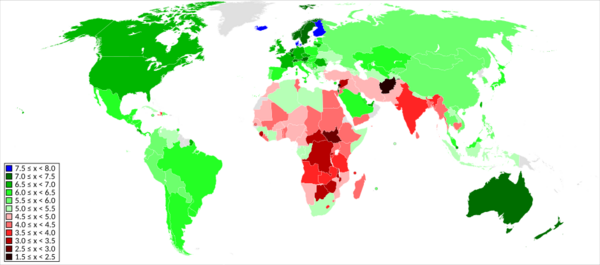Happiness facts for kids
Happiness is a wonderful feeling of joy and positivity. When you feel good, proud, excited, or satisfied about something, you are feeling "happy." Being happy can help you relax and make you smile.
Happiness is often seen as the opposite of sadness. But sometimes, you can feel both at the same time! This might happen if you're happy about one thing and sad about another, or even if you have mixed feelings about the same situation.
As people grow up, what makes them happy can change. When you're younger, friends, cool stuff, and money might seem like the main sources of happiness. As adults get older, they often find happiness more in their relationships, like with their family and friends, and in having inner peace.
Many philosophers, who are thinkers who study big ideas, have said that life has ups and downs. Everyone experiences both happy and sad times. No one is always happy or always sad. In ancient civilizations like the Incas and the Mayans, happiness was seen as very important, even a key to love.
Contents
Understanding Happiness
How We Measure Happiness
For hundreds of years, people have tried to figure out how to measure happiness. In 1780, a thinker named Jeremy Bentham suggested that since happiness is so important to people, governments should measure it to see how well they are doing.
Today, we often measure happiness by asking people how they feel. This is usually done through surveys where people report their own happiness levels. Sometimes, our memories of how we felt can be a bit off, or it's hard to predict how happy we will be in the future.
Even with these challenges, experts who study happiness and money (called "happiness economists") still use surveys to find out how happy groups of people are.
Here are some ways people try to measure happiness:
- Subjective Happiness Scale (SHS): This asks people to rate how happy they are overall.
- Positive and Negative Affect Schedule (PANAS): This survey asks about different positive and negative feelings you might have.
- Satisfaction with Life Scale (SWLS): This asks how satisfied you are with your life in general.
- Cantril Ladder: This method asks people to imagine a ladder from 0 (worst possible life) to 10 (best possible life) and then rate where they are.
- Positive Experience Survey: This survey asks if people experienced things like enjoyment, laughter, or feeling well-rested the day before.
- Oxford Happiness Inventory: This is a detailed survey with many questions to understand a person's well-being.
Since 2012, a special report called the World Happiness Report has been published every year. It uses these types of measurements to find out which countries have the highest levels of happiness. Countries like the UK and Bhutan also measure the well-being of their citizens.
Experts agree that many things contribute to how happy adults are. These include feeling fair, having freedom, being part of a community, and being involved in activities. All these factors can help increase happiness, even if they don't all improve at the same time.
It's interesting to know that a person's general level of happiness tends to stay quite steady over time.
How Happiness Affects Us
Being happy and in a good mood can have many positive effects on your life. Studies show that happy people tend to be:
- More helpful and generous to others.
- More cooperative and less aggressive.
- More likely to help people in need.
- More sociable and communicative.
Happiness also seems to help with:
- Solving problems in creative ways.
- Sticking with challenges even when they are tough.
- Feeling more motivated to do work or responsible tasks.
- Making good decisions more easily.
There's also a link between happiness and physical health. Studies show that happy people often have better health. Happiness can even help people live longer, especially if they are already healthy.
What Philosophers Said About Happiness
Aristotle's View
About 2,300 years ago, a famous Greek philosopher named Aristotle wrote that happiness is the only thing humans truly want for its own sake. Things like money, honor, health, or friendship are often wanted because they can lead to happiness, but happiness itself is the main goal.
For Aristotle, happiness (which he called eudaimonia) was more than just a feeling. It was about living well and doing well, like an activity or a way of life.
Nietzsche's View
Later, another philosopher named Friedrich Nietzsche had a different idea. He thought that making happiness your only goal in life could actually make you "contemptible," meaning not worthy of respect. He believed that striving for happiness as the ultimate aim was not what humans truly desired.
Fun Facts About Happiness
- Scientists have found a possible link between the size of a certain part of your brain (called the right precuneus) and how happy you feel.
- One researcher, Sonja Lyubomirsky, suggests that about half of your happiness level might be set by your genes. About 10% is affected by your life situations, and the remaining 40% is something you can control yourself!
- Research shows that having good mental health and strong relationships makes people happier than just having a lot of money.
- Happy people tend to smile more often, are more social, and are more willing to help others.
- While some people think that being successful makes you happy, studies suggest that happiness can actually come *before* success in things like income, relationships, and work.
- Richer countries often have higher levels of happiness than poorer ones. However, getting richer has a bigger impact on happiness in poor countries than in already wealthy ones.
- Many studies show that people who volunteer (helping others without being paid) tend to be happier and healthier.
- Happiness is a very important idea in Buddhist teachings. Buddhists believe that true, lasting happiness comes from overcoming suffering and desires, leading to a state called Nirvana, which is everlasting peace.
- In Judaism, happiness (called simcha) is seen as an important part of serving God.
- In a philosophy called Advaita Vedanta, the main goal of life is to find ultimate happiness.
Images for kids
-
A smiling 95-year-old man from Pichilemu, Chile
See also
 In Spanish: Felicidad para niños
In Spanish: Felicidad para niños










